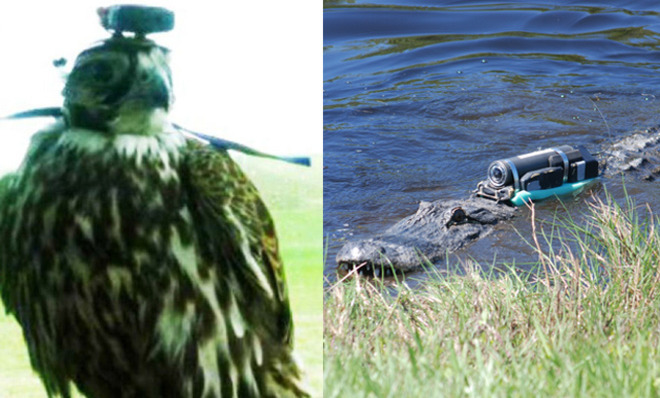Watch a falcon and an alligator hunt — from their point of view
By mounting cameras on two formidable predators, scientists get rare glimpses into how they capture their prey

When a peregrine falcon goes into its hunting stoop — the high-speed dive that brings it in for the kill — it can reach speeds of up to 242 miles per hour. How does a flock of birds react when the fastest thing in the animal kingdom is barreling down on them?
Suzanne Amador Kane, a physicist at Haverford College who studies the motion of flocks, swarms, and other groups of animals, wanted to find out. To help analyze and interpret the prey's reactions, she wanted to read up on the behavior of their predators, but found that there wasn't much research on falcons' hunting practices.
So Kane shifted her focus from the hunted to the hunter. She hooked up with falconers across the U.S. and Europe who volunteered to attach miniature cameras to their birds' flight caps and harnesses, providing a bird's eye view of an aerial attack. When all the videos were collected, Kane mapped out the falcons' positions frame by frame, and reconstructed their flight paths during the hunts.
The Week
Escape your echo chamber. Get the facts behind the news, plus analysis from multiple perspectives.

Sign up for The Week's Free Newsletters
From our morning news briefing to a weekly Good News Newsletter, get the best of The Week delivered directly to your inbox.
From our morning news briefing to a weekly Good News Newsletter, get the best of The Week delivered directly to your inbox.
The simplest strategy for the falcons would be to fly straight at the prey, but having to shadow their targets' moves through the whole pursuit would be inefficient. Another option would be to follow a spiral path that other researchers had theorized based on studies with model birds.
Instead, Kane found that the falcons first fixed their targets in their field of view, and adjusted their paths so that the prey stayed in the same position against the background. This strategy not only helps falcons head off prey to save time and effort, but also makes it seem, from the prey's perspective, that the falcon isn't moving with them.
Meanwhile, University of Florida biologist James Nifong and researchers from other southern institutions wanted to fill the gaps in their knowledge about a much larger predator, the American alligator. As top predators in the swamps, rivers, and other waters of the Southeast, gators are a crucial influence on these ecosystems. They're also big, dangerous, and mostly active at night, leaving their hunting and feeding behaviors understudied.
Until now, researchers had been limited to watching captive animals, studying dead gators' stomach contents, and gathering anecdotal reports from people who live near alligators. Nifong and his colleagues decided to try a different approach.
A free daily email with the biggest news stories of the day – and the best features from TheWeek.com
They captured 15 alligators, attached "Crittercams" designed by National Geographic to their heads, and then released them back into the waters around Cape Canaveral. A few days later, the self-detaching cameras were collected, and Nifong and his team began going through the 70 hours of footage. The gators' home movies revealed two big secrets: How often they hunt, and what makes for a successful attack.
Alligators, it turns out, are more prolific hunters than biologists had thought. On average, the gators tracked in the study attacked another animal once every two hours, with some overachievers attacking far more frequently — one gator attempted 18 attacks in the same hour.
On average, they successfully killed and ate a meal every four hours. The success or failure of those attacks seemed to hinge on the time of day and the location of the gator. The animals attacked more frequently at night, likely because that's when small prey like crayfish and minnows tend to school, or because this scheduling helps the gators maintain body temperature. However, their hunts were more successful in the morning and early daytime, when prey were easier to detect.
Gators also had twice as many successful hunts when they were submerged in water than when they were floating on the surface. Nifong has a couple of ideas to explain this: Either prey animals in deeper water are less evasive, or gators can use both sight and pressure sensors in their snout to detect prey.
-
 A long weekend in Fontainebleau
A long weekend in FontainebleauThe Week Recommends Less than an hour from Paris, this historic town is perfect for a short break
-
 Political cartoons for December 16
Political cartoons for December 16Cartoons Tuesday’s editorial cartoons include calibrating fonts, Christmas classics, and more
-
 Cryptocurrency and the future of politics
Cryptocurrency and the future of politicsIn The Spotlight From electoral campaigns to government investments, crypto is everywhere and looks like it’s here to stay